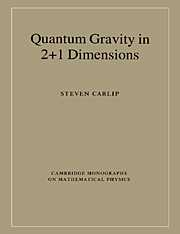Book contents
- Frontmatter
- Contents
- Preface
- 1 Why (2+1)-dimensional gravity?
- 2 Classical general relativity in 2+1 dimensions
- 3 A field guide to the (2+1)-dimensional spacetimes
- 4 Geometric structures and Chern–Simons theory
- 5 Canonical quantization in reduced phase space
- 6 The connection representation
- 7 Operator algebras and loops
- 8 The Wheeler–DeWitt equation
- 9 Lorentzian path integrals
- 10 Euclidean path integrals and quantum cosmology
- 11 Lattice methods
- 12 The (2+1)-dimensional black hole
- 13 Next steps
- Appendix A The topology of manifolds
- Appendix B Lorentzian metrics and causal structure
- Appendix C Differential geometry and fiber bundles
- References
- Index
5 - Canonical quantization in reduced phase space
Published online by Cambridge University Press: 15 December 2009
- Frontmatter
- Contents
- Preface
- 1 Why (2+1)-dimensional gravity?
- 2 Classical general relativity in 2+1 dimensions
- 3 A field guide to the (2+1)-dimensional spacetimes
- 4 Geometric structures and Chern–Simons theory
- 5 Canonical quantization in reduced phase space
- 6 The connection representation
- 7 Operator algebras and loops
- 8 The Wheeler–DeWitt equation
- 9 Lorentzian path integrals
- 10 Euclidean path integrals and quantum cosmology
- 11 Lattice methods
- 12 The (2+1)-dimensional black hole
- 13 Next steps
- Appendix A The topology of manifolds
- Appendix B Lorentzian metrics and causal structure
- Appendix C Differential geometry and fiber bundles
- References
- Index
Summary
Having examined the classical dynamics of (2+1)-dimensional gravity, we are now ready to turn to the problem of quantization. As we shall see in the next few chapters, there are a number of inequivalent approaches to quantum gravity in 2+1 dimensions. In particular, each of the the classical formalisms of the preceding chapters – the ADM representation, the Chern–Simons formulation, the method of geometric structures – suggests a corresponding quantum theory.
The world is not (2+1)-dimensional, of course, and the quantum theories developed here cannot be taken too literally. Our goal is rather to learn what we can about general features of quantum gravity, in the hope that these lessons may carry over to 3+1 dimensions. Fortunately, many of the basic conceptual issues of quantum gravity do not depend on the number of dimensions, so we might reasonably hope that even a relatively simple model could provide useful insights.
After a brief introduction to some of the conceptual issues we will face, I will devote this chapter to a quantum theory based on the ADM representation of chapter 2. As we saw in that chapter, the ADM decomposition and the York time-slicing make it possible to reduce (2+1)-dimensional gravity to a system of finitely many degrees of freedom. Quantum gravity thus becomes quantum mechanics, a subject we believe we understand fairly well. This approach has important limitations, which are discussed at the end of this chapter, but it is a good starting place.
- Type
- Chapter
- Information
- Quantum Gravity in 2+1 Dimensions , pp. 87 - 99Publisher: Cambridge University PressPrint publication year: 1998

